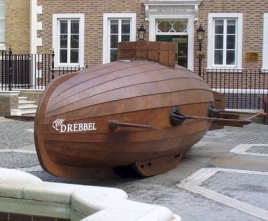Invention of the submarine

Leonardo da Vinci (1452-1519) made sketches of a submarine and William Bourne, a British mathematician, drew plans for a submarine in 1578. But it was only in 1620 that Cornelis van Drebbel, a Dutch inventor, managed to build a navigable submarine.
Van Drebbel wrapped a wooden rowboat tightly in waterproofed leather and had air tubes with floats to the surface to provide oxygen. Of course, there were no engines yet, so the oars went through the hull at leather gaskets. Van Drebbel took the first trip with 12 oarsmen in the Thames River – staying submerged for 3 hours.
Military submarines
The first submarine used for military purposes was built in 1776 by David Bushnell (1742-1824) of the US. His “Turtle” was a one-man, wooden submarine powered by hand-turned propellers. It was used during the American Revolution against British warships.
The Turtle would approach enemy ships partially submerged to attach explosives to the ship hulls. The Turtle worked well but the explosives did not.
Two rival inventors from the US developed the first true submarines in the 1890s. The US Navy purchased submarines built by John P Holland, while Russia and Japan opted for the designs of Simon Lake. Their submarines used petrol or steam engines for surface cruising and electric motors for underwater travel. They also invented torpedoes which were propelled by small electric motors, thereby introducing one of the most dangerous weapons in the world.
Submarines are also called U-boats, which is short for Unterseeboot, the German word for undersea boat.
The first nuclear-powered submarine, the USS Nautilus (SN-571), was launched in 1955. In 1958 the Nautilus made the first voyage under the polar ice pack, completing the 2945 km (1,830 miles) journey in 6 days.
The first submerged circumnavigation of earth was made in 1960 by the nuclear submarine USS Triton.
Source: https://didyouknow.org/submarine/





